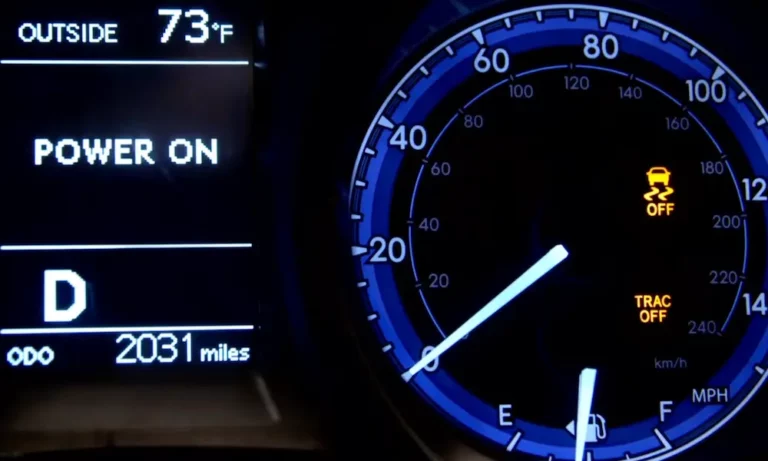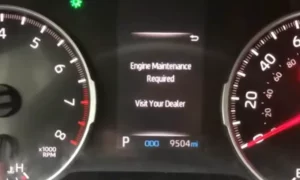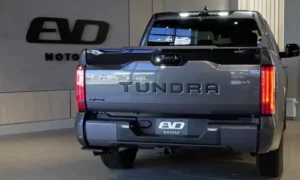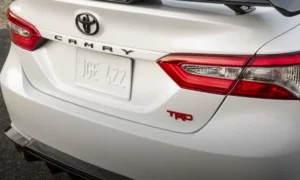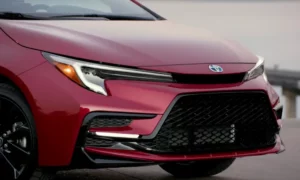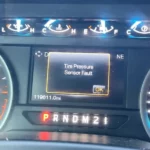Ever glanced at your Toyota’s dashboard and spotted that annoying VSC light glowing back at you? You’re looking at your Vehicle Stability Control system trying to tell you something. Whether it happened after routine maintenance or seemingly out of nowhere, that little light can cause big worries.
Getting your Toyota back to normal doesn’t always require an expensive trip to the dealership. In many cases, you can reset the VSC light yourself with some straightforward methods that work for most Toyota models, including popular ones like the Camry, Corolla, and Highlander.
What Exactly Is Vehicle Stability Control?
Toyota’s VSC system is your invisible driving assistant. It constantly monitors your car’s movement and helps keep you safely on your intended path, especially when road conditions get tricky.
The VSC system works by:
- Automatically applying brakes to individual wheels when it detects skidding
- Reducing engine power when needed to regain traction
- Working together with your anti-lock braking system (ABS)
- Helping maintain vehicle control during emergency maneuvers
Since 2012, stability control systems have been mandatory in all new vehicles sold in the US—that’s how important they are for safety.
Why Is My Toyota’s VSC Light On?
That illuminated VSC light can signal various issues, from minor concerns to more serious problems. Here are the most common culprits:
Common VSC Light Triggers
- Simple issues: Something as basic as a loose gas cap or low tire pressure can activate the light
- Sensor problems: Faulty wheel speed sensors, steering angle sensors, or yaw rate sensors
- Engine troubles: In Toyota models with 3.5 V6 2GR-FE engines, worn spark plugs and ignition coils frequently trigger VSC warnings
- Recent maintenance: Sometimes the VSC light comes on after routine service if sensors weren’t properly recalibrated
- Computer glitches: Occasional electronic hiccups in the system
- Steering rack issues: Problems with the power steering system can trigger VSC warnings
What makes diagnosis tricky is that the VSC system is interconnected with multiple other vehicle systems. This explains why seemingly unrelated issues like spark plug problems can trigger the VSC light.
Easy DIY Methods to Reset Your Toyota VSC Light
Here are three proven methods to reset your Toyota’s VSC light, ranging from super simple to moderately technical.
Method 1: The VSC Button Reset
This is the quickest and easiest approach for temporary VSC issues:
- Stop your vehicle completely and shift to park
- Find the VSC button (usually near the gear shifter or on the dashboard)
- Press and hold the button for about 3 seconds
- Watch as both “TRAC OFF” and “VSC OFF” lights illuminate on your dashboard
- Press the button once more to reactivate the systems
This method works for most Toyota models with minor variations in button location. It’s perfect for situations where you just need a quick system reset after something like battery replacement or minor service work.
Method 2: OBD2 Scanner Method
For more persistent issues, an OBD2 scanner helps identify and clear specific trouble codes:
- Find your vehicle’s OBD2 port (typically under the dashboard on the driver’s side)
- Connect your scanner to the port
- Turn the key to the “on” position without starting the engine
- Use the scanner to search for VSC-related trouble codes
- Record any codes you find (they’ll look something like “C1201” or “P0300”)
- Use the scanner’s “clear codes” function to reset the system
- Restart your vehicle to confirm the reset worked
The advantage here is that you’ll actually see what triggered the light through specific error codes before clearing them. Basic OBD2 scanners start around $30, making this a cost-effective approach compared to dealership visits.
Method 3: Zero Point Calibration
This more advanced method works well after suspension modifications or when sensors need recalibration:
- Park on a perfectly level surface
- Locate the diagnostic port (often under the hood)
- Find the pins marked E1 and TS
- Use a jumper wire to temporarily connect these pins
- Turn the ignition on (don’t start the engine)
- Short the pins at least 4 times within 8 seconds
- Watch for both ABS and traction control lights to flash simultaneously
- Turn the ignition off and remove the wire
- Turn the ignition on again – the warning lights should now flash more rapidly
- Turn the ignition off once more, then restart your vehicle
This method effectively resets the zero point of your yaw and deceleration sensors, which is particularly helpful after vehicle modifications or when the VSC light activates immediately upon driving.
Diagnosing Specific VSC Issues Before Resetting
Before you reset anything, it helps to understand what triggered the VSC light in the first place. Here’s how to check some common causes:
Check Your Tire Pressure
Low or uneven tire pressure is a surprisingly common VSC trigger. Use a pressure gauge to check all four tires against the recommended PSI listed on your driver’s door jamb sticker.
Inspect the Gas Cap
A loose or damaged gas cap can trigger multiple warning lights, including VSC. Make sure it clicks several times when tightening.
Look for Check Engine Lights
If your check engine light is also on, the VSC system might be responding to an engine-related issue. The engine problem needs fixing before the VSC system will fully reset.
Examine Recent Service History
Did the light appear after an oil change, battery replacement, or other service? Some maintenance procedures can temporarily trigger the VSC system, making a simple reset all you need.
Model-Specific VSC Reset Instructions
Different Toyota models may have slight variations in their VSC reset procedures. Here are specifics for popular models:
Toyota Camry VSC Reset
In most Camry models (2007-2023), the VSC button is located on the dashboard, to the left of the steering wheel or near the gear shifter. Follow Method 1, pressing and holding the button until the lights indicate system deactivation.
Toyota Corolla VSC Reset
For Corolla models, the VSC button is typically found on the lower dashboard or near the gear shifter. In newer models, it might be integrated into the touchscreen menu system under “Vehicle Settings.”
Toyota Highlander VSC Reset
Highlander owners should look for the VSC button near the center console or gear shift area. In some models, you’ll need to press and hold the button for 5 seconds rather than the standard 3 seconds.
Toyota RAV4 VSC Reset
In the RAV4, the VSC switch is often located near the gear shifter. Some models require you to press the button three times in succession rather than holding it down.
When DIY Isn’t Working: Next Steps
If you’ve tried the reset methods above and the VSC light keeps returning, it’s time to dig deeper:
Check for These Common Sensor Issues
The VSC system relies on several sensors that can fail or become miscalibrated:
- Wheel speed sensors: Located near each wheel hub, these can get damaged or collect debris
- Steering angle sensor: Found in the steering column, this can need recalibration after alignment work
- Yaw rate sensor: Usually located under the center console, this measures your car’s rotation around its vertical axis
Try a Battery Disconnect
Sometimes, a full electrical reset can help:
- Disconnect the negative battery terminal
- Press the brake pedal for 30 seconds to drain any residual power
- Wait 15 minutes
- Reconnect the battery
- Start the engine and check if the VSC light returns
Known Issues with Specific Toyota Models
Some Toyota models have known VSC-related issues:
- 2007-2009 Camry: Often experiences VSC light activation due to throttle body issues
- 2010-2015 Prius: Frequently shows VSC warnings related to brake actuator problems
- 2004-2007 Highlander: Common issues with the steering angle sensor triggering VSC lights
Common VSC-Related Error Codes and Their Meanings
If you’re using an OBD2 scanner, these codes can point to specific issues with your VSC system:
| Error Code | Meaning | Common Fix |
|---|---|---|
| C1201 | Engine Control System Malfunction | Check engine for issues first |
| C1223 | Skid Control System Malfunction | Check ABS sensor connections |
| C1336 | Zero Point Calibration Incomplete | Perform zero point calibration |
| C0200-C0210 | Wheel Speed Sensor Issues | Inspect specific wheel sensor |
| C1210 | Brake Fluid Pressure Sensor Circuit | Check brake fluid level and sensor |
This table can help you target the exact problem rather than just clearing codes without fixing the underlying issue.
Is It Safe to Drive with the VSC Light On?
While you can technically drive with the VSC light illuminated, it means your stability control system isn’t working. Consider these factors:
- Normal conditions: On dry, straight roads in good weather, you might not notice any difference
- Adverse conditions: In rain, snow, or during emergency maneuvers, you’ll lack the safety net VSC provides
- Other warning lights: If the ABS or brake warning lights are also on, your overall braking system may be compromised
The safest approach is to address VSC issues promptly rather than driving extended periods with the system disabled.
Preventive Maintenance to Avoid VSC Problems
You can reduce the chances of VSC issues with these preventive steps:
Regular Service Checks
- Have your Toyota’s computer systems scanned during regular maintenance
- Ensure proper alignment and tire balance at recommended intervals
- Replace spark plugs according to the maintenance schedule
Driving Habits
- Avoid driving through deep water which can damage wheel speed sensors
- Don’t ignore minor warning lights that could cascade into VSC issues
- Be cautious about aftermarket modifications that might interfere with factory sensors
Weather Considerations
During winter, ice and snow buildup around wheel wells can interfere with speed sensors. Regularly clean these areas in snowy conditions to prevent false VSC activations.
The VSC System: A Critical Safety Feature Worth Maintaining
Your Toyota’s VSC system isn’t just another electronic gadget—it’s a sophisticated safety system that can prevent accidents and help maintain control in dangerous situations.
When that VSC light comes on, taking the time to properly diagnose and reset the system ensures you’ll have this important safety feature working when you need it most. Whether you use the simple button reset, an OBD2 scanner, or need to perform a sensor calibration, the peace of mind is worth the effort.
For most common VSC issues, the reset methods in this guide will get your Toyota back to normal operation without an expensive dealership visit. But remember: if the light keeps returning despite your best efforts, consulting with a professional technician is the wisest choice for your safety and your vehicle’s longevity.

